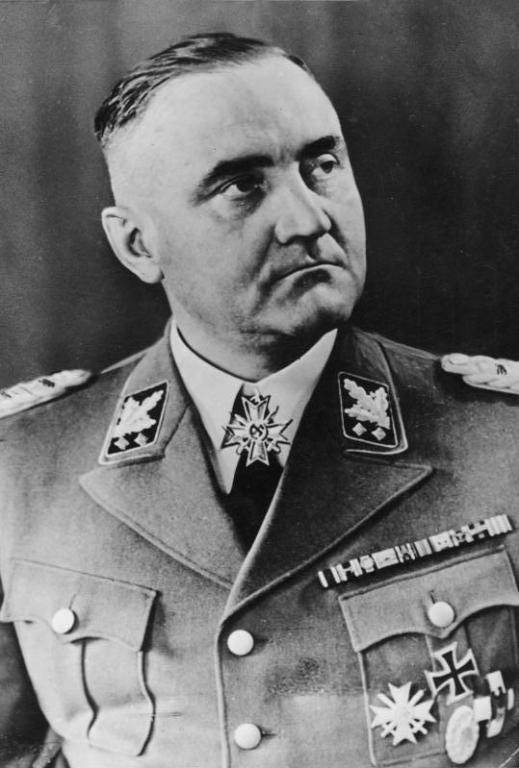-
Legacy Member

From what I’ve been told, GI’s didn’t take many SS prisoners after the Malmedy massacre.
-
Thank You to Vincent For This Useful Post:
-
05-11-2016 11:27 PM
# ADS
Friends and Sponsors

-
Contributing Member


Correct Vincent and one could imagine the reaction of the British troops to Herr Hitl*rs "Commando order" to be summarily shot off hand if caught
troops to Herr Hitl*rs "Commando order" to be summarily shot off hand if caught
-
Thank You to CINDERS For This Useful Post:
-
Contributing Member


Oberegruppenfuhrer der Waffen SS Gottlob Berger

Berger claimed that it was in fact the Germans’ duty under the Geneva Convention to remove POWs from a potential combat zone, as long as it did not put their lives in even greater danger. He also claimed that the rapid advance of the Red Army had surprised the Germans, who had planned to transport the POWs by train. He claimed that he had protested about the decision, made by Hitler, according to him, but he was “without power or authority to countermand or avoid the order”. The case failed due to these claims and the lack of eyewitness evidence—most ex-POWs were completely unaware of the trial taking place. He was however convicted in 1949 for his role in the genocide of European Jews and sentenced to 25 years in prison. The sentence was reduced to 10 years in 1951 because of his refusal to kill “The Prominent” in Oflag IV-C at Cholditz Castle,despite direct orders from Adolf Hitler. He had helped these prisoners escape by moving them to Bavaria and then onto Austria where he met up with them twice before they were returned to American forces. He claimed that he had saved the Prominent as Ernst Kaltenbrunner, head of the RSHA, had sent a group of extremists to try to kill them. After the war, he claimed that Hitler had wanted more shootings of prisoners and more punishments, but that he had resisted this. In 1948, Berger gave details to an American judge in Nuremberg of Hitler’s plans to hold 35,000 Allied prisoners hostage in a “last redoubt” in the Bavarian mountains.
where he met up with them twice before they were returned to American forces. He claimed that he had saved the Prominent as Ernst Kaltenbrunner, head of the RSHA, had sent a group of extremists to try to kill them. After the war, he claimed that Hitler had wanted more shootings of prisoners and more punishments, but that he had resisted this. In 1948, Berger gave details to an American judge in Nuremberg of Hitler’s plans to hold 35,000 Allied prisoners hostage in a “last redoubt” in the Bavarian mountains.

On the counts under which he was convicted, Berger was sentenced to 25 years imprisonment, but received credit for the nearly four years during which he been in custody awaiting trial. Peter Maguire observes that given the status of the defendants and the body of evidence against them, the sentences given to all those indicted in the Ministries Trial were light
The sentences were reviewed by an Advisory Board for Clemency for War Criminals, which was responsible for providing advice to the U.S. High Commissioner for Germany John J. McCloy. On 31 January 1951, McCloy determined to reduce Berger's sentence to 10 years imprisonment, stating that he appeared to have been unjustly convicted for the murder of Mesny, and that McCloy had given greater weight to Berger's active interventions "to save the lives of Allied officers and men who under Hitler orders were held for liquidation or as hostages".[133] McCloy did not explain why Berger could not be held responsible for the murder of Mesny, despite the majority finding of the tribunal that Berger bore "command responsibility" for the murder.[134] Berger was released from Landsberg prison in December 1951, having spent a total of six and a half years in custody.
John J. McCloy. On 31 January 1951, McCloy determined to reduce Berger's sentence to 10 years imprisonment, stating that he appeared to have been unjustly convicted for the murder of Mesny, and that McCloy had given greater weight to Berger's active interventions "to save the lives of Allied officers and men who under Hitler orders were held for liquidation or as hostages".[133] McCloy did not explain why Berger could not be held responsible for the murder of Mesny, despite the majority finding of the tribunal that Berger bore "command responsibility" for the murder.[134] Berger was released from Landsberg prison in December 1951, having spent a total of six and a half years in custody.
Last edited by Mark in Rochester; 05-12-2016 at 12:56 PM.
He is no fool who gives what he cannot keep to gain that which he cannot lose
There are no great men, only great challenges that ordinary men are forced by circumstances to meet.
-
The Following 3 Members Say Thank You to Mark in Rochester For This Useful Post:
-
-
-
FREE MEMBER
NO Posting or PM's Allowed

Other give away is I believe the 100TMX on the negative is code for 100TMax, which Kodak didn't come out with until long after the war. A period film from Kodak would likely be Panatomic X (a super low speed film) or in the field likely Verichrome, as IIRC Tri-X wasn't sold for 35mm still cameras until after the war even though it existed as movie film then. Good photo though.
Last edited by cipherk98; 05-13-2016 at 10:35 PM.














 PM
PM








 Is the SS man not "Steamboat Willie" from 'Saving private Ryan'?
Is the SS man not "Steamboat Willie" from 'Saving private Ryan'?

